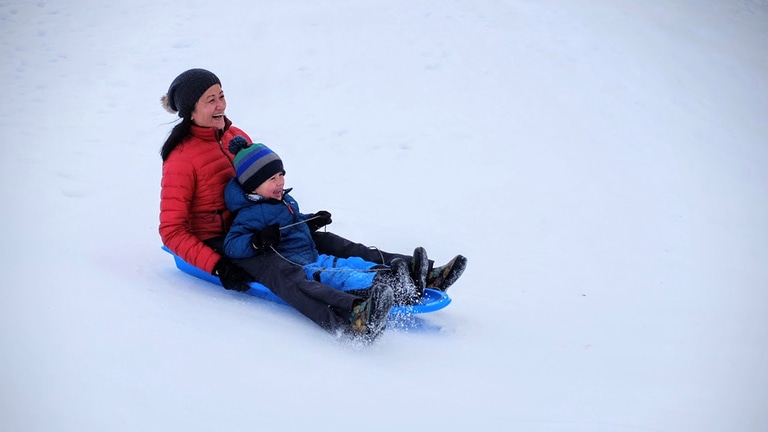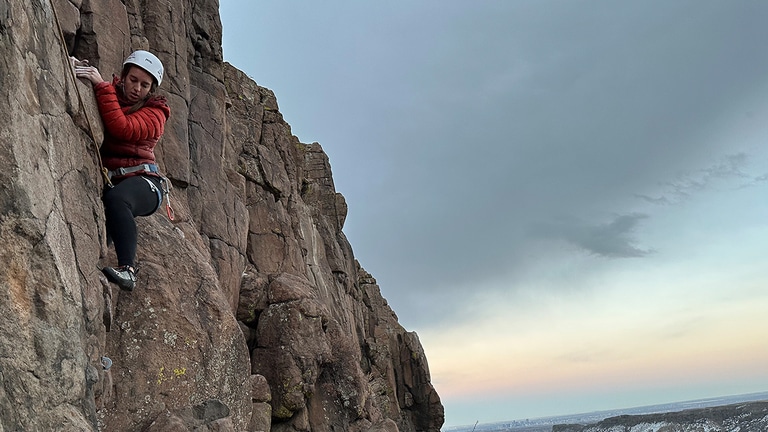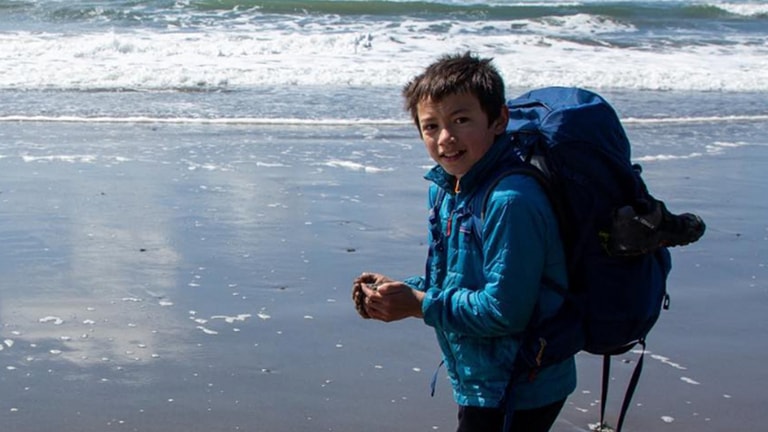Mastering a layering system takes work. But once you've done it, we think you'll never go back. Layering systems are typically made up of a base layer, a mid layer and an outer layer. An insulated jacket, typically worn as a warm outer layer or a mid layer, is a key element in this equation because it keeps your core warm by trapping precious body heat without adding bulk or weight.
So, how do you choose the best insulated jacket for you among the myriad options? Don’t worry: We have you covered with our guide on "How to Choose Insulated Outerwear." Your choices for insulation material are primarily down or synthetic insulation, and in this guide we'll walk you through some options for the best down jackets and the best synthetic insulation jackets. We reviewed feedback from REI staffers and users like you to determine the top crowdsourced options for a range of specific needs. Read on for favorite puffy jackets available at REI.
For more outerwear recommendations, visit our Best Winter Jackets, Best Rain Jackets and Best Fleece Jackets gear guides.
Staff Picks
For quick recommendations, check out our favorites here. Or scroll down for more in-depth reviews.
- Best Insulated Jacket for Everyday Wear: Patagonia Down Sweater
- Best Insulated Jacket for Backpacking: REI Co-op Magma 850 Down Hoodie
- Best Insulated Jacket for Camping: Cotopaxi Fuego Hooded Down Jacket
Best Insulated Jacket for Adventurers on a Budget: REI Co-op 650 Down Jacket
Best Insulated Jacket for Really Cold Adventures: REI Co-op Stormhenge 850 Down Hybrid Jacket
- Best Insulated Synthetic Jacket for Snowsports: Arc'teryx Atom Insulated Hoody
- Best Insulated Synthetic Jacket for Hiking: Patagonia Nano Puff Jacket
Best Down Jackets
Best Insulated Jacket for Everyday Wear
Patagonia Down Sweater
Insulation 800-fill-power down certified to the Global Traceable Down Standard
Weight 10.3 oz. (women's size M); 13 oz. (men's size M)
There may be no better choice for cold-weather active pursuits or around-town jaunts than the Patagonia Down Sweater. It's well under 1 pound, packs down small and has a middle-of-the-road fit that accommodates most folks. Plus, it's made using recycled materials and goose down certified to the Global Traceable Down Standard. With loads of well-thought-out extra features, it's a go-to for everyday wear.
"It's an all-around generalist," says REI merchant Katie Smyth. One of our Expert Advice editors wears the Down Sweater for everything from chilly walks to shoulder-season camping, hiking and backpacking trips. The jacket's versatility comes from its lightweight, 800-fill-power goose down and a horizontal baffling pattern that eliminates cold spots. Perhaps most importantly, the fit is tailored without being too narrow. The Down Sweater now comes in extended sizes—up to XXL in women's sizes and XXXL in men's sizes.
You'll find hem drawcords inside the Down Sweater's slightly undersized pockets so you can easily cinch the hem without exposing your hands to the cold. The front zipper tucks into a zipper garage at the chin, which helps to prevent chafing. There's also an interior chest pocket that doubles as a stuff sack. And because this version of the Down Sweater lacks a hood, it nestles neatly under a rain or ski jacket if you're looking for furnace-like warmth on the move. (It's also available in a hooded version for $50 more.)
"Because it's so lightweight, I always find room for it on backpacking trips because I know it'll keep me warm without the bulk," says Expert Advice managing editor, Phuong Le (pictured sledding with her kid in the Down Sweater). "But it's so versatile that the jacket is also my go-to mid layer on colder ski days." Buy here.

Best Insulated Jacket for Backpacking
REI Co-op Magma 850 Down Hoodie
Insulation 850-fill-power goose down (bluesign approved)
Weight 10.5 ounces (women's), 12.5 ounces (men's)
Leading groups of visitors in Yosemite National Park has its ups (hiking to the 8,844-foot apex of Half Dome, for example) and its downs (say, exploring Yosemite Valley). The REI Co-op Magma 850 Down Hoodie is ready for it all, confirms one backpacking guide. “I can attest to the [jacket’s] performance in the unpredictable mountain weather,” says Sarah Dolan. She notes that the jacket’s 850-fill-power goose down (the highest among the down jackets on our list) provides a high warmth-to-weight ratio and easily stuffs down into the small crannies of a full pack (or in the jacket’s own pocket). A heat-sealing internal draft tube in the neck and nonfluorinated durable water repellent (DWR) treatment boost protection against the cold and precipitation, respectively. “This hoodie has consistently kept me comfortable and protected from the elements,” our guide adds.
It’s not just cold and rain, however, that the Magma 850 can withstand. The jacket’s fully recycled ripstop nylon shell stands up to the rubbing of backpack straps, while its raglan sleeves, articulated elbows and body-mapped insulation enhance ease of movement when setting up camp. Melissa Chieffe, an REI senior marketing strategist, was impressed with the Magma's toughness on a recent rock climbing trip to Golden Cliffs in Colorado when temps dipped and she needed an extra layer. "Happy to report that it didn't rip, even though I was sliding all over rock," says the climber, pictured on rock at Golden Cliffs in Colorado.
And, says another staffer, the Magma 850 is adaptable enough to handle variable weather conditions. "Likely to be my go-to everyday down jacket for both active pursuits and trips to the grocery store," he says, though he found the hood too square for his taste. Indeed, other reviewers complained of a too-boxy fit. And one reviewer noted that the location of the hood adjustment on the back of the head "makes the jacket uncomfortable if you want to sleep with the hood up for extra warmth." Still, one of our Pennsylvania-based gear tester instantly loved the Magma 850 and uses it "on everything from hikes, a round of golf, dog walks, and you name it. It is super light, incredibly warm, packs well, and looks amazing.” The jacket comes with a hoodie or without. Buy all versions here.

Best Winter Jacket for Camping
Cotopaxi Fuego Hooded Down Jacket
Fabric 20-denier ripstop nylon with durable water repellent (DWR) finish
Waterproof Water-resistant
Windproof No
Insulation 800-fill-power goose down
Warmth Level Warmer
Weight 14 oz.
The colorful and cozy Cotopaxi Fuego Hooded Down Jacket is a co-op staff and member campsite favorite, earning this 800-fill-power goose down coat a nearly five-star rating. "Great minimal jacket for an alpine or backpacking layer system," says a reviewer from Ohio. Another says, "I wanted a nice warm jacket so I didn't have to layer all the time. This jacket is great for the fall in Utah, it keeps you warm at 40°F. It's super lightweight and comfy [so] you'll forget you're even wearing it." In fact, the entire Fuego line—including a vest, parka and the ridiculously awesome down overalls—is top-rated at the co-op.
Of course, the Fuego is eye-catching—as are most other products from this certified B Corporation dedicated to "gear for good." But the Fuego is much more than a pretty face. It's made with a durable 20-denier ripstop nylon exterior lining to resist scratches from errant branches and unwieldy tent poles. The water-resistant goose down insulation keeps your trunk and arms toasty, and a drawcord hem and elastic bindings at the hood and cuffs prevent drafts from wafting in. A scuba hood protects your neck from the chill. Zippered hand pockets offer more protection from the cold, and a stash pocket is perfect for a trail snack; the whole coat stuffs into an interior pocket for easy packing and quick layering. One note: The coat itself isn't waterproof or windproof. If there's rain or snow in the forecast, bring a hard shell to wear over this puffy. Buy women’s. Buy men’s.
Best Insulated Jacket for Adventurers on a Budget
REI Co-op 650 Down Jacket
Insulation 650-fill-power down certified to the Responsible Down Standard
Weight 10.2 oz. (women's size M); 10.9 oz. (men's size M)
Puffies aren't cheap, but you can still grab this one from REI Co-op for about half the cost of others in our lineup. And you won't be making any extreme sacrifices for the price either. The 650 Down Jacket is stuffed with 650-fill-power down, packs down small and comes in loads of sizes (including a kids' version and a infant/toddlers' version).
Dawn Fahlstrom, an REI Co-op retail specialist, says she reaches for the 650 Down Jacket when she has room to only bring one coat. "The key question for picking a jacket is, how often are you going to use it?" she says. This one handles decently on active pursuits as an outer layer (the shell blocks wind and is treated with a durable water repellent coating) or mid layer (the insulation fluffs up well, even after being compressed into its own pocket). Katie Smyth, an REI merchant, notes that the jacket's fit is relaxed, not technical, but it still layers well.
Some reviewers noticed frayed seams over a year's time, and a few feathers popped out. Still, the 650 Down Jacket is a bargain for the price, and it's made with materials certified to bluesign criteria. Buy here.
Best Winter Jacket for Snowshoeing
REI Co-op Stormhenge 850 Down Hybrid Jacket
Fabric 94% recycled ripstop nylon/3% nylon/3% polyester; recycled nylon with polyurethane coating (hood, shoulders, lower body, cuffs)
Waterproof Yes
Windproof Yes
Insulation 850-fill-power goose down (body and lower arms); 98% recycled 180 g polyester (upper/lower body and side panels); 98% recycled 80 g polyester (hood, underarms, cuffs) (all bluesign® approved)
Warmth Level Warmer
Weight 1 lb. 6.9 oz (women's), 1 lb. 13.6 oz. (men's)
Just like your favorite rom-com star, the Stormhenge Down Hybrid Jacket from REI Co-op features a gruff exterior but is a total softy inside. Its durable water repellent (DWR)-treated, double-layer HydroWall shell repels even the wettest flakes, and 850-fill-power goose down insulation in the body and lower arms help keep it überwarm while staying compressible and lightweight (under 2 pounds).
When snowshoeing, we're more likely to sweat under our arms and on our backs (especially while wearing a pack), so it makes sense to look for a jacket featuring relatively lightweight, breathable fabrics in these areas. The Stormhenge features 180-gram recycled-fiber synthetic insulation that's mapped to the upper and lower body as well as side panels that retain warmth when wet and dry quickly. The jacket's down baffles are welded to the shell to better hold in warmth and prevent cold spots. A draft tube in the collar (like what you find in many sleeping bags) further deters heat loss.
What does that look like in action? "The Stormhenge moves beautifully, is well-insulated without being bulky and doesn't get soaked through when I'm shoveling," says Ever Meister, hike editor for Expert Advice, adding that the jacket stands up to their home state Minnesota's -60°F windchill. "Another bonus for that shoveling: pit zips! I always overheat when I'm taking care of the sidewalk, but the easy ventilation on this little number keeps me going comfortably." A three-way adjustable hood fits over a helmet in case you want to take the Stormhenge skiing. Buy women’s. Buy men’s.
Best Synthetic Insulated Jackets
Best Synthetic Insulated Jacket for Snowsports
Arc'teryx Atom Insulated Hoody
Insulation 60g Coreloft Compact synthetic fibers
Weight 11.3 oz. (women's size M); 12.5 oz. (men's size M)
If you're looking for a high-performance puffy jacket that will move with you, reach for the Arc'teryx Atom Insulated Hoody. It's loaded with 60 grams of synthetic insulation, but stretchy side paneling and articulated arms help you feel nimble, whether on the slopes or other snowy adventures.
When worn beneath a shell like a mid layer, that same stretch paneling also allows for venting so you can dump heat if you're working hard. Designers at Arc'teryx placed the insulation of the Atom on the front and back of the torso to retain warmth. The insulation itself is synthetic (called Coreloft Compact), making it more breathable and quicker-drying than down jackets but not as warm as the Patagonia Down Sweater. If a particularly gruesome yard sale ends with snow down your shell, the Atom will still insulate when wet too.
"Arc'teryx is a design company and they take every detail into account," says Fahlstrom, our retail sales specialist in Dallas. The Atom has a low-profile hood that fits under a helmet and has a mini brim for some rain protection. The cuffs are buttery-soft, making for easy removal and layering, and the Atom durable face fabric is tough enough to handle being worn as an outer layer. Plus, it provides light rain protection, thanks to a durable water repellent coating.
"This jacket is a reliable, versatile workhorse," says one of our REI Expert Advice editors who has used hers as a mid layer while downhill skiing, on rainy mountain bike rides and as a go-to piece for international travel. "I've stuffed this into backpacks and crammed it into my travel carry-on, and still it remains as durable and as sleek as ever." Note: The Arc'teryx Atom is also available in hoodless options (women's and men's). Prefer a down option? Consider the Arc'teryx Cerium Insulated Hoody. Buy the Atom Insulated Hoody here.
Best Winter Jacket for Hiking
Patagonia Nano Puff Insulated Jacket
Fabric Recycled polyester
Waterproof Water-resistant
Windproof Yes
Insulation 60 g PrimaLoft Gold Insulation Eco postconsumer recycled polyester
Warmth Level Warm
Weight 10 oz. (women's), 11.9 oz. (men's)
The REI staff just can't get enough of the Nano Puff Jacket from Patagonia, which is warm and windproof thanks to 60 grams of PrimaLoft® Gold Insulation Eco. The synthetic insulation retains its warming abilities when damp and a brick-quilting pattern ensures the insulation stays put, making it a perfect winter hiking companion.
"Everyone in our family owns Nano Puff jackets that have lasted us for years," says Phuong Le, Expert Advice managing editor who's based in wet and chilly Seattle. She adds that they use the jacket for all seasons and multiple activities (but they don't wear matching colors). "It's our mid layer of choice when we don't want the thickness of fleece, and though it's not waterproof, it has surprisingly kept us all warm through some unexpected rainy hiking adventures."
Emma Cullen, who works on the REI paid media team and lives in snowy Idaho, adds that the Nano Puff lives up to its name. "I barely remember that I’m wearing a jacket when in the Nano Puff," she says. "It's so lightweight and moves with me whether I'm ripping skins, using hiking poles or just out for a dog walk. This is the perfect jacket to keep as a 'just in case' layer in a bag since it is so small but can be so warm."
Know who else loves the Nano Puff? Your Mother (Earth, that is). The jacket's recycled insulation comprises 100% post-consumer material, and its fully recycled polyester ripstop shell features a moisture-shedding durable water-repellent (DWR) finish that's free from perfluorinated chemicals. (Other Nano Puff products include a parka, hoodie and mittens.) Also available in kids’ and infants'/toddlers’. Buy women’s. Buy men’s.

Shop All Down Jackets Shop Synthetic Insulation Jackets
Buying Advice
Consider these factors when buying an insulated jacket to get you through winter adventures.
What makes for a good down jacket?
A good down jacket should contain lightweight, compressible insulation. In most cases, a down jacket will have the highest warmth-to-weight ratio of any product you own (except for maybe your sleeping bag). It should fit close to your body, but it shouldn't be so form-fitting that you can't comfortably wear one or two layers underneath.
What is down fill power?
Fill power is the number that indicates the relative quality of down, ranging from about 450 to 900. A higher fill count means more loft (or fluff). The REI Co-op Magma 850 Down Hoodie and REI Co-op Stormhenge 850 Down Hybrid Jacket have the highest fill count—with 850-fill-power goose down—among down jackets in this guide, with the Patagonia Down Sweater and Cotopaxi Fuego Hooded Down Jacket not far behind at 800 fill power. Down fill power matters because loft is an important indicator of a jacket's insulation. Down insulates you well because of the formation of small air spaces within the down's plumules (superfine featherlike plumage). The more loft you have, the more heat-trapping air space there will be in the jacket. (For more information, check out our guide to down fill count.) While a jacket like the REI Co-op 650 Down Jacket has a lower count, it costs about half as much as its loftier counterparts.
What is the Responsible Down Standard?
Some jackets like the Patagonia Down Sweater are certified to the Responsible Down Standard (RDS). To get an RDS label, a brand must prove that their down feathers came from animals that were treated well. An RDS certification requires that the ducks and geese in question were free of hunger, thirst, discomfort, pain, injury, disease, fear and distress. (For more details, visit Responsible Down Standard.)

When should I buy a synthetic jacket instead of a down jacket?
A synthetic jacket like the Arc'teryx Atom Insulated Hoodie or Patagonia Nano Puff Jacket might be right for you if you plan to be outdoors in a wet place or if you're undertaking a sweaty activity (like running). Synthetic materials are also generally less expensive than down. Down, however, is usually warmer, more compressible and a bit lighter. But down loses its insulating power when it gets wet, and it takes a long time to dry compared to jackets with synthetic insulation. The decision between the two is yours and will entirely depend on what kinds of adventures you're planning to take. (For more on this decision, visit our down vs. synthetics insulation guide.)
How should I care for and maintain my down jacket?
Down jackets can lose their insulating properties when they get wet or dirty, so you'll want to clean your jacket every so often to keep it at its best. Most down jackets can be washed in a front-loading home washing machine. But make sure to read your jacket's instruction label before tossing it in. If you do wash your jacket at home, use a gentle, detergent-free cleaner (Nikwax's Down Wash is made just for this situation). Then, dry your jacket on low heat with a few clean tennis balls in the mix to break up clumps. (Down tends to clump when wet, and it can take a while to dry, so be patient.) You should also store your down products on hangers rather than compressing them. (For more cleaning tips, visit our down jacket cleaning guide.) If your jacket rips or tears, you can patch it with gear repair tape. Check out our guide on how to repair a down jacket at REI.
Our Process
To pick the best insulated jackets, whether down or synthetic, we asked our REI retail staff and other employees for their favorite puffies sold at the co-op. We read through dozens of customer reviews on REI.com and spoke with several outdoor experts to get a sense for what matters most in a good insulated jacket. Then, we narrowed our list down to the ones that performed best for a variety of activities, whether camping in the cold or running errands around town.
































































